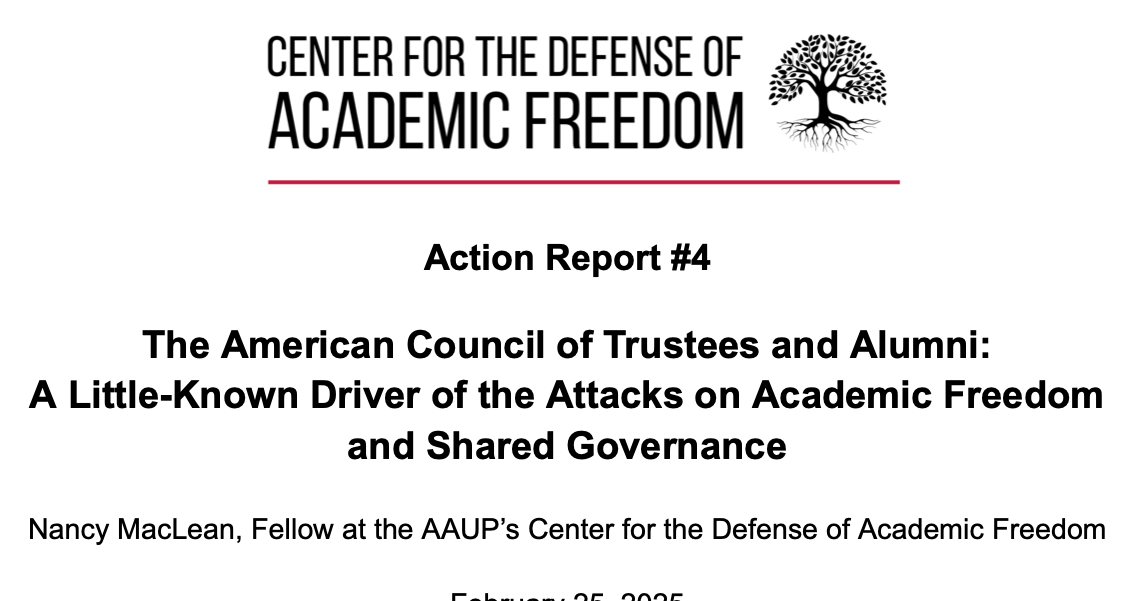This story from the New York Times in the immediate aftermath of Harvard’s defiance against Trump administration threats that amounted to a demand to take over the university is just too much:
Let me get this straight. The choice to launch a full assault on the richest and most prestigious institution of higher education in the world, a move which the Times characterizes as a “tectonic battle,” had been done without whomever is supposed to be in charge giving the go-ahead.
According to the Times reporters, “The April 11 letter from the White House’s task force on antisemitism, this official told Harvard, should not have been sent and was ‘unauthorized,’ two people familiar with the matter said.”
I have a live shot from the Trump higher ed task force:
This strikes me as an important bit of information when it comes to resisting these assaults on higher ed/academic freedom/democracy.
These guys have agendas, but they don’t have plans, and that is a serious weakness.
The agenda is to either subjugate or destroy those whom they believe to be threats to their power. Higher ed is among those enemies, so operating on a clearly disingenuous rationale (combatting anti-semitism) coming from a group that tripped over themselves excusing Elon Musk’s double Nazi salute, they’ve gone on the attack.
But what this exchange with Harvard reveals is that there is no serious thought beyond the initial attack. They assume that the attack, coming from an entity as mighty as the federal government, is enough to get the entity being attacked to back down. Rather than a sign of strength, it’s a declaration of weakness. Once the shock and awe is over, there’s not much left.
The demands were so outsized and literally impossible that Harvard, who had previously been in discussions with the Trump administration, had no choice but to fight, rolling out a multi-pronged public communication offensive defending itself and the principles of free inquiry and independent educational institutions. Satirical newspaper, The Onion, was moved to offer this commentary:
Harvard choosing to publicly face down the threats - an option they apparently weren’t necessarily going to take at this time - has galvanized additional opposition, including protests across multiple campuses, while also shifting the conversation from the administration’s fig leaf excuse of combating antisemitism to what is really happening, a full-frontal assault on democratic institutions.
Unwittingly, the Trump administration's misfire has given higher ed a great opportunity to exemplify the values that animate our work.
As AAUP spokesperson, Kelly Benjamin, told the Associated Press in commenting on these protests, “College campuses have historically been the places where these kind of conversations, these kind of robust debates and dissent take place in the United States,” Benjamin said. “It’s healthy for democracy. And they’re trying to destroy all of that in order to enact their vision and agenda.”
Having a vision and agenda without a consequent plan is not unique to the attacks on higher ed. In just about every other major issue, from tariffs, to immigration, to the economy, we see a movement swinging wildly, the public justifications for these actions shifting day-to-day.
Now that the shock has worn off and we’ve seen tangible examples of the benefits of organized resistance, the situation is quickly turning. A handful of weeks ago, it appeared like most institutions were going to try to stay silent as the fury passed over them, but this week, hundreds of university presidents (and growing) signed an AAC&U letter condemning the attacks.
Alumni are activating to protect their alma maters, and students - the greatest asset any institution has in fighting this fight - are eager to engage, provided they feel supported and in league with their administrations.
Collectively, it seems as though higher ed is waking up to the fact that the Trump administration is determined to damage or destroy higher education, and the best way to mitigate that damage is to fight.
The fact that Trump has no plan and their immediate response to Harvard standing up was “oops,” should give others courage going forward.
I want to highlight some resources provided by the Center for the Defense of Academic Freedom to aid in this fight.
At this post, we have a capsule description and a link to a fuller document for how to respond if your National Science Foundation grant has been terminated. There are rules and regulations that must be followed, and it is important for those affected to assert their rights.
Resources You Can Use to Fight for Academic Freedom
The threats to academic freedom aren’t going to stop. Subscribe in order to stay current on the work of CDAF and others working to protect our democratic institutions.
I also wanted to highlight this recent post of a Q&A with CDAF fellow Mary Anne Franks and, how directly challenging the false framing of bad faith attacks on institutions can pierce the veil of propaganda.
Piercing the Propaganda
The threats to academic freedom aren’t going to stop. Subscribe in order to stay current on the work of CDAF and others working to protect our democratic institutions.
Let us know if you’ve seen other actions in defense of academic freedom that you believe deserve highlighting.
The views expressed in this newsletter are those of individual contributors and not those of the American Association of University Professors (AAUP) or the AAUP’s Center for the Defense of Academic Freedom.









